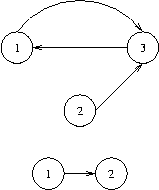POJ 2553
来源:互联网 发布:数据分析 excel 编辑:程序博客网 时间:2024/06/05 11:43
题意:如果v点能够到的点,反过来也能够到v点,则称这个点为sink点,输出所有的sink点
思路:求下强连通分量,出度为0的连通分量里的点都是sink点
代码:
#include<iostream>#include<cstdio>#include<cstring>#include<vector>#include<stack>using namespace std;const int maxn = 1e4+5;int n, m, dfn[maxn], low[maxn], belong[maxn], out[maxn];int dfs_clock, scc_cnt;bool is[maxn];vector<int> g[maxn];stack<int> s;void tarjan(int u){ dfn[u] = low[u] = ++dfs_clock; s.push(u); for(int i = 0; i < g[u].size(); i++) { int v = g[u][i]; if(!dfn[v]) { tarjan(v); low[u] = min(low[u], low[v]); } else if(!belong[v]) low[u] = min(low[u], dfn[v]); } if(low[u] == dfn[u]) { scc_cnt++; while(1) { int x = s.top(); s.pop(); belong[x] = scc_cnt; if(x == u) break; } }}void find_scc(){ while(!s.empty()) s.pop(); dfs_clock = scc_cnt = 0; memset(belong, 0, sizeof(belong)); memset(dfn, 0, sizeof(dfn)); for(int i = 1; i <= n; i++) if(!dfn[i]) tarjan(i);}void solve(){ memset(out, 0, sizeof(out)); memset(is, 0, sizeof(is)); for(int u = 1; u <= n; u++) for(int i = 0; i < g[u].size(); i++) { int v = g[u][i]; if(belong[u] != belong[v]) out[belong[u]]++; } for(int i = 1; i <= scc_cnt; i++) if(!out[i]) is[i] = 1; int lead = 0; for(int i = 1; i <= n; i++) if(is[belong[i]]) { if(lead++) printf(" "); printf("%d", i); } puts("");}int main(void){ while(cin >> n && n) { scanf("%d", &m); for(int i = 0; i < maxn; i++) g[i].clear(); for(int i = 1; i <= m; i++) { int u, v; scanf("%d%d", &u, &v); g[u].push_back(v); } find_scc(); solve(); } return 0;}The Bottom of a Graph
Time Limit: 3000MS Memory Limit: 65536KTotal Submissions: 10891 Accepted: 4491
Description
We will use the following (standard) definitions from graph theory. Let V be a nonempty and finite set, its elements being called vertices (or nodes). Let E be a subset of the Cartesian product V×V, its elements being called edges. Then G=(V,E) is called a directed graph.
Let n be a positive integer, and let p=(e1,...,en) be a sequence of length n of edges ei∈E such that ei=(vi,vi+1) for a sequence of vertices (v1,...,vn+1). Then p is called a path from vertex v1 to vertex vn+1 in G and we say that vn+1 is reachable from v1, writing (v1→vn+1).
Here are some new definitions. A node v in a graph G=(V,E) is called a sink, if for every node w in G that is reachable from v, v is also reachable from w. The bottom of a graph is the subset of all nodes that are sinks, i.e., bottom(G)={v∈V|∀w∈V:(v→w)⇒(w→v)}. You have to calculate the bottom of certain graphs.
Let n be a positive integer, and let p=(e1,...,en) be a sequence of length n of edges ei∈E such that ei=(vi,vi+1) for a sequence of vertices (v1,...,vn+1). Then p is called a path from vertex v1 to vertex vn+1 in G and we say that vn+1 is reachable from v1, writing (v1→vn+1).
Here are some new definitions. A node v in a graph G=(V,E) is called a sink, if for every node w in G that is reachable from v, v is also reachable from w. The bottom of a graph is the subset of all nodes that are sinks, i.e., bottom(G)={v∈V|∀w∈V:(v→w)⇒(w→v)}. You have to calculate the bottom of certain graphs.
Input
The input contains several test cases, each of which corresponds to a directed graph G. Each test case starts with an integer number v, denoting the number of vertices of G=(V,E), where the vertices will be identified by the integer numbers in the set V={1,...,v}. You may assume that 1<=v<=5000. That is followed by a non-negative integer e and, thereafter, e pairs of vertex identifiers v1,w1,...,ve,we with the meaning that (vi,wi)∈E. There are no edges other than specified by these pairs. The last test case is followed by a zero.
Output
For each test case output the bottom of the specified graph on a single line. To this end, print the numbers of all nodes that are sinks in sorted order separated by a single space character. If the bottom is empty, print an empty line.

Sample Input
3 31 3 2 3 3 12 11 20
Sample Output
1 32
1 0
- POJ 2553
- poj 2553
- POJ 2553
- POJ 2553
- poj 2553
- POJ 2553
- poj 2553 tarjan算法
- POJ 2553-题意很重要...
- poj 2553 tarjan
- poj 2553 强连通
- poj 2553 强连通
- poj 2553
- POJ 2553&&ZOJ 1979
- poj 2553 Tarjan
- poj-2553 Frogger
- POJ 2553 Tarjan
- POJ
- poj
- ubuntu16.04 安装 Eric6
- JZOJ1332. 正方形内的计数
- uva 11077 Find the Permutations 置换+递推
- spark-streaming-[2]-累加器(更新器)操作(updateStateByKey)
- C#编程实现获取当前计算机的名字
- POJ 2553
- poj1474 Video Surveillance【半平面交】
- 步循环
- 提高篇项目1-统计数组中某个数出现的有几次
- java进制与字节之间的转换
- poj 1068
- LintCode 50 数组剔除元素后的乘积
- BZOJ 3884 上帝与集合的正确用法
- NYOJ 211 闭包的传递 Floyd


